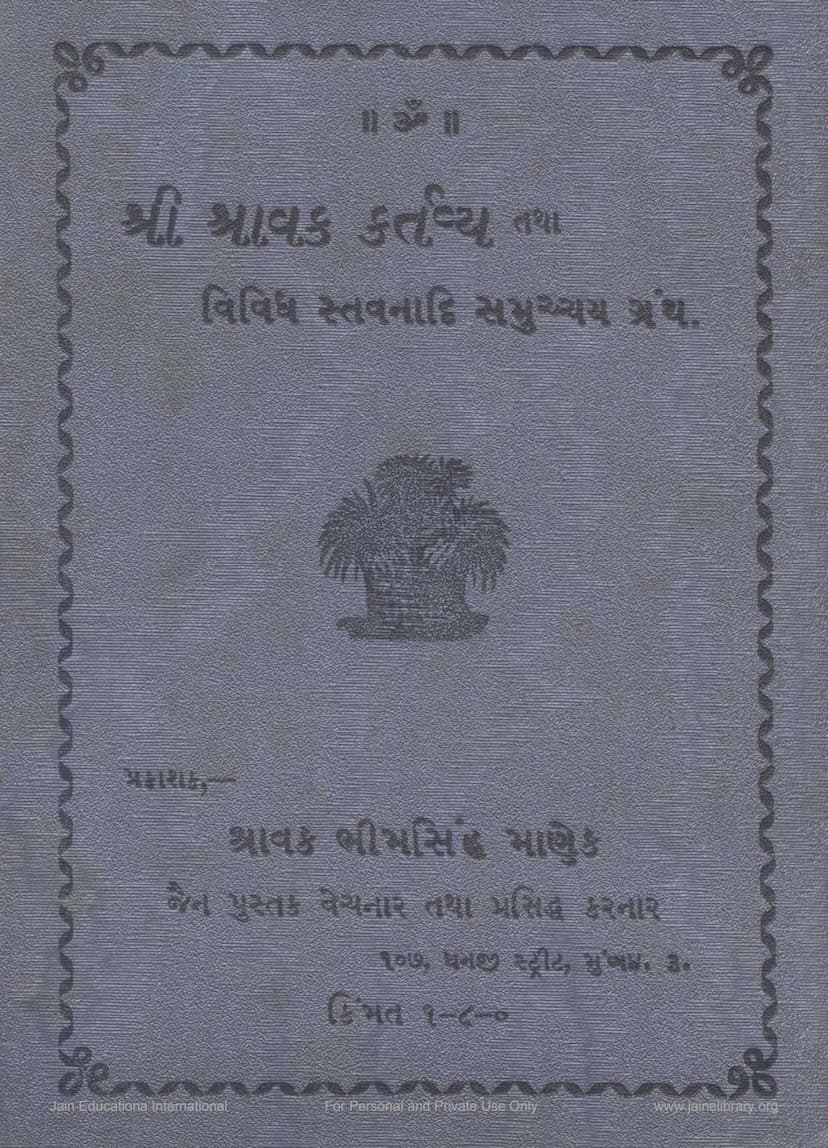Shravak Kartavya Tatha Vividh Stavanadi Samucchaya Granth
Added to library: September 2, 2025

Summary
Based on the provided Jain text, here's a comprehensive summary in English:
Book Title: Shravak Kartavya tatha Vividh Stavanadi Samucchaya Granth (Duties of a Lay Follower and Collection of Various Devotional Songs and Verses)
Author: Shravak Bhimsinh Manek
Publisher: Shravak Bhimsinh Manek
Overall Purpose: This book is a collection of various Jain texts, rituals, devotional songs (stavan, saajh, lavani, etc.), and guidelines for lay followers (Shravaks and Shravikas). Its primary aim is to educate and guide Jain lay followers in their religious practices, emphasizing the proper way to perform temple visits, worship, and understand the underlying philosophies. It seeks to address and rectify potential issues like "ashatana" (disrespect or neglect) in temple rituals.
Key Contents and Themes:
-
Introduction to Jain Philosophy and Practice:
- Importance of Devotion and Devotion: The book stresses the significance of visiting temples and worshipping the Jinadeva (Tirthankaras) not just for outward show but for inner purification and spiritual progress. It highlights that the true purpose of devotion lies in recognizing the divine qualities and striving to embody them.
- The Role of Purusharth (Effort): It emphasizes that mere presence or performing rituals without the right intention or effort (purusharth) will not yield the full spiritual benefits. The text encourages understanding the purpose behind the actions.
- Patience and Forgiveness (Kshama): Page 3 is dedicated entirely to the virtues of patience and forgiveness, calling them paramount in spiritual life, leading to knowledge, self-control, contentment, and ultimately, liberation.
- Purity (Bahya Shuddhi and Antar Shuddhi): It details the importance of both external (physical) and internal purity when approaching the divine. This includes cleanliness of the body and surroundings, as well as controlling impure thoughts and intentions.
-
Rituals and Temple Conduct:
- Nishidhi Trika: A crucial section explains the "Nishidhi Trika," a three-part ritual of renunciation performed at different stages of entering the temple and approaching the deity. This involves mentally leaving behind worldly affairs, temple-related business, and finally, the focus shifting from material worship to spiritual contemplation.
- Pradakshina: The significance of circumambulating the deity is explained in terms of seeking the three jewels (Samyak Darshan, Samyak Gyan, Samyak Charitra) and the ultimate goal of liberation.
- Avagraha and Vandan: The text outlines the three types of "Avagraha" (distance to maintain from the idol) and three types of "Vandan" (forms of bowing or greeting the deity), emphasizing respectful and mindful interaction.
- Pratimapuja (Idol Worship): It explains the purpose and meaning behind idol worship, stating that images are representations of the Tirthankaras and serve as focal points for meditation and inspiration. It describes "Dravya Puja" (material worship) with 21 types of offerings, highlighting the devotional intention behind each.
- Bhav Puja (Spiritual Worship): This is presented as the higher form of worship, focusing on contemplating the virtues of the Tirthankaras and aspiring to cultivate them within oneself. It distinguishes between "Prashast Rag" (pure attachment) and mere ritualistic performance.
-
Devotional Literature and Practices:
- Stavans (Devotional Songs): A significant portion of the book is dedicated to a vast collection of "Stavans" and "Sajhay" (devotional songs and verses) for various Tirthankaras, occasions (like festivals, specific tithis), and purposes (like renunciation, self-reflection).
- Navkard Mantra Mahatmya: The supreme importance and efficacy of the Navkar Mantra are discussed with numerous examples and verses.
- Specific Hymns and Prayers: The book includes various prayers and hymns like "Gautam Swami ka Ras," "Navkaran Mantra," "Chetyavandan," "Namthuhu," "Javanti Cheiyai," and "Jay Veeryay."
- Pancha Kalyanak: The five auspicious events in the life of a Tirthankara are also detailed.
-
Guidance for Lay Followers (Shravak Dharma):
- Daily Routine: It outlines a recommended daily schedule, including waking up early, performing rituals, visiting the temple, and managing household duties.
- Discipline and Rules: It elaborates on the importance of adhering to the 12 vows (Vratas) of a lay follower, offering a concise explanation of each. It also mentions 14 specific rules (Niyam) for lay followers and 21 virtues (Gun) to cultivate.
- Right Livelihood (Ajeevika): It discusses various ways of earning a livelihood, emphasizing ethical practices and renouncing occupations that cause harm to living beings (Pancham Karmadan). It categorizes the seven types of occupations and ranks trade as the best.
- Financial Discipline: The importance of managing income and expenditure, saving, and using wealth for religious and charitable purposes is highlighted.
- Living in Accordance with Time and Place (Desh Kaal Viruddh): It stresses the need to follow societal norms and customs, avoid actions that are against regional practices, and respect the prevailing era's conventions.
- Abstinence from Night Meals (Ratri Bhojan Tyag): This practice is strongly recommended for its health and spiritual benefits.
-
Emphasis on Inner Understanding:
- Meaning of Mantras and Stotras: The book encourages readers to understand the meaning and essence of the mantras and stotras they recite, rather than just chanting them mechanically.
- Reflection and Self-Contemplation: It promotes introspection on one's own conduct and spiritual progress, aligning with the teachings of the Tirthankaras.
Structure and Organization: The book is extensive, covering a wide range of topics categorized into different "Khal" (sections). The table of contents (Anukramanika) reveals a meticulously organized structure, listing numerous stavan, chaitavandan, shlokas, and explanatory sections.
Publisher's Note: The publisher, Shravak Bhimsinh Manek, expresses gratitude to various scholars and text sources consulted during the compilation. They also acknowledge the possibility of errors due to oversight or haste and request readers to point them out for correction in future editions.
In essence, "Shravak Kartavya tatha Vividh Stavanadi Samucchaya Granth" is a comprehensive manual for Jain lay followers, aiming to instill a deeper understanding of Jainism, promote righteous conduct, and foster a strong devotional connection with the Tirthankaras through a rich collection of prayers, songs, and practical guidance.